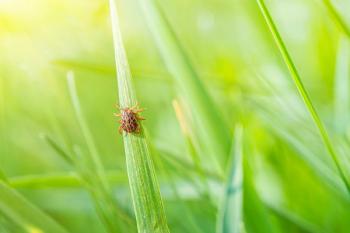
Exotic small mammal parasitology (Proceedings)
Parasites are a common finding in wild-caught and captive small exotic mammals.
Parasites are a common finding in wild-caught and captive small exotic mammals. In general, parasitic relationships are not meant to kill the host. However, due to the restrictions placed on an exotic species in captivity (e.g., limited space, inadequate nutrition), parasitic infestations can be devastating.
Parasites are generally classified into two major groups: ectoparasites and endoparasites. The most common ectoparasites reported in exotic small mammals are mites, lice, and fleas. Endoparasites generally include all parasites found within the host. Most endoparasites are found within the host's gastrointestinal tract, although endoparasites can also migrate to other areas within the host (e.g., liver, brain, kidney, blood).
Ectoparasites are a common finding on recently imported exotic small mammals, and captive species housed outdoors or in close approximation to domestic pets. Most species of mites and lice are species specific, whereas fleas and ticks are not. Special precautions, such as wearing exam gloves, should be taken when working with these species to prevent the spread of potentially zoonotic pathogens. Diagnosis of an ectoparasite infestation can be made during a thorough physical examination. Many of the larger ectoparasites can be readily identified with the naked eye, whereas further diagnostics, such as a tape preparation or skin scrape, are required to identify microscopic ectoparasites.
Ear mites are one of the most common parasites observed in the author's practice. Otodectes cynotis is the ferret ear mite. Affected ferrets generally have dark ceruminous wax within the external ear canal and may frequently scratch at their ears. Psoroptes cuniculi is the rabbit ear mite. This mite can cause severe inflammation and crusting of the external ear canal. Rabbits with P. cuniculi may have painful ears, so a clinician should exercise caution when manipulating the ears. Diagnosis can be made on cytological examination. Ivermectin (0.2-0.4 mg/kg q 2 weeks for 3 treatments) is an effective treatment for ear mites.
The rabbit fur mite, Cheyletiella parasitovorax, is an infrequent finding in pet rabbits. Infested rabbits look as if they have "walking dandruff". Diagnosis can be made from a skin scrape or acetate tape preparation. The life cycle of this parasite is approximately 35 days. Ivermectin (0.4 mg/kg q 2 weeks for 3 treatments) is the treatment of choice.
Sarcoptic mange, caused by Sarcoptes scabei, affects many mammalian species. Affected animals often develop severe, intense pruritis, scales, crusts, erythema, and generalized alopecia. Pododermatitis and self-mutilation are common findings in ferrets. Humans that become infested with sarcoptic mange may develop wheals, vesicles, papules, and intense pruritis. Infected animals should be quarantined from other animals and only handled with gloves, to reduce exposure. Lime sulfur shampoos, ivermectin, and selamectin may be used to treat affected animals.
Chorioptes sp. is a common ectoparasite of African hedgehogs. Affected animals may present with crusty skin and spine loss. Microscopic examination of a skin scraping will confirm diagnosis. The mites can be eradicated by giving the animal three treatments of ivermectin (0.2 mg/kg) at two-week intervals.
Trixacarus caviae is the common mite of the guinea pig. In general, guinea pigs infested with T. caviae are asymptomatic. However, animals that are maintained in poor conditions or are stressed may develop generalized clinical signs, including alopecia, intense pruritis, scales, crusts, and hyperkeratosis. Pet owners, especially children, may become infected with T. caviae from direct contact with infected guinea pigs. Affected individuals generally develop mild dermatitis. Trixacarus caviae is difficult to eliminate in guinea pigs. Intensive environmental cleaning and treatment using ivermectin or selamectin has been found to be effective.
Rabbits housed outdoors are susceptible to Cuterebra spp. infestation. These large obligate parasites are generally found in the subcutis of rabbits. Affected rabbits will present with swelling(s) in the cervical, axillary, inguinal regions. These larval swellings have a characteristic air hole associated with them. Treatment can be accomplished by surgical removal of the larvae. The procedure can be performed using a local anesthetic (lidocaine) or under general anesthesia. Blunt dissection may be used to enlarge the air hole and extract the parasite.
Fleas (Ctenocephalides spp.) are a frequent finding on ferrets and rabbits housed outdoors or in households where domestic species have access to the outdoors. Management of flea infestations in exotic pets should be two-fold, treating both the environment and the animal. Flea sprays and powders that are safe for puppies and kittens are generally safe for ferrets and rabbits too. Imidacloprid (Advantage, Bayer, Shawnee Mission, KS) and lufenuron (Program, Novartis, Greensboro, NC) have both been used to eliminate fleas in ferrets and rabbits. Fipronil (Frontline, Merial, Duluth, MN) has been used in ferrets, but is not recommended for rabbits.
Because the majority of the small exotic mammals sold in the United States are captive born and raised, endoparasites are an uncommon finding. However, many of these mammals are susceptible to the same species of protozoa that can infest humans and domestic species. In cases where these protozoa are identified, it is likely that a human or another domestic species may have served as the reservoir for the parasite.
Cryptosporidium parvum does not appear to be host specific and may infect a wide range of mammals. Exotic small mammals with cryptosporidiosis are generally asymptomatic. However, those animals that are chronically stressed and /or have a compromised immune system may develop clinical signs, including diarrhea, vomiting, and muscle wasting. Fatal intestinal cryptosporidiosis has been reported in African hedgehogs and ferrets, suggesting that these animals may pose a zoonotic threat to their caretakers.
Giardia spp. have been isolated from a number of different exotic small mammals. Clinical signs vary depending on the species of Giardia and the general health status of the infected animal. In severe cases, animals can succumb to severe dehydration and loss of essential electrolytes. Transmission is direct. Diagnosis and treatment of the affected animal(s) to prevent further shedding and proper hygiene after handling animals will prevent the spread and transmission of this protozoal parasite to humans and other domestic species.
Cestodes, trematodes and nematodes are an uncommon finding in exotic small mammals. A fecal floatation using an appropriate flotation solution (e.g., sodium nitrate) can be done to identify large parasite eggs (e.g. roundworms, tapeworms, and flukes). A recently imported exotic mammal that is parasite-free on an initial fecal examination should be re-tested at 2 and 4 week intervals because shedding of parasite eggs can be transient.
Newsletter
From exam room tips to practice management insights, get trusted veterinary news delivered straight to your inbox—subscribe to dvm360.






